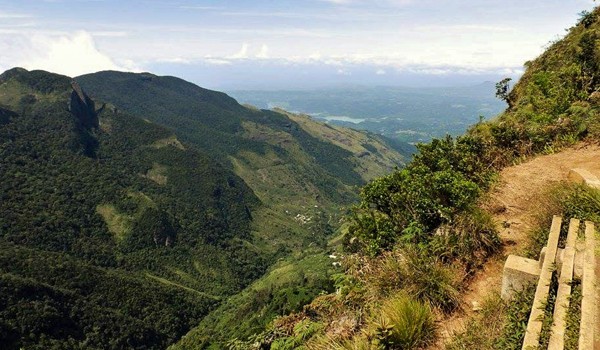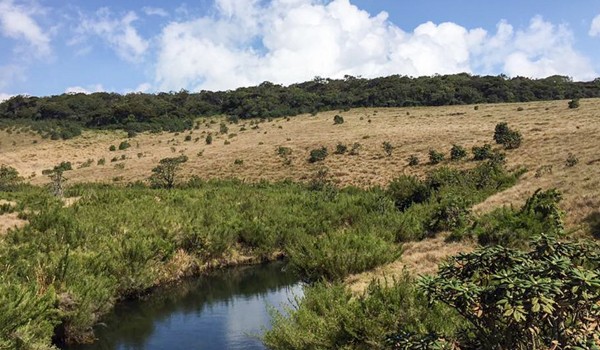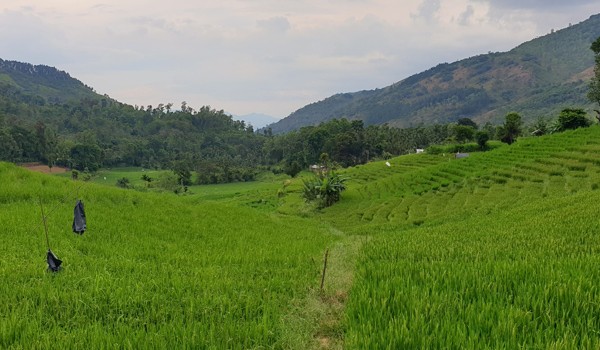Horton Plains National Park, a UNESCO World Heritage site, is situated in the Central Highlands of Sri Lanka at an altitude of as much as 2,300 meters. This positioning creates its uniqueness and the park is vastly different to any other national park in Sri Lanka, attracting a diverse array of birds and mammals. Being close to the tea country, this park should be on the list of any wildlife enthusiasts for bushwalks and walking safaris.
This biodiversity hotspot is situated over 3,160 hectares of land, with nearly 60 percent montane grasslands and the balance being subtropical montane evergreen forests. Half of the woody plants are endemic to Sri Lanka. Frequent cloud cover minimises the exposure to sun creating a range of temperature and flora and fauna distinct and special to the park. While the mean temperature is around 13°C, the nights can get as low as 4°C – 5°C. The highest temperature is around 28°C. Rainfall is received during the southwest monsoons from May to September making the park misty and moist. The lower lying areas of the park tend to receive significantly more rain than the rest. The park is the headwaters to three large rivers in the country. It is also an important watershed and consists of slow moving streams, waterlogged swamps and waterfalls. Twenty-four species of mammals and 87 species of birds have made Horton Plains their home.

This is also an important bird area and attracts migratory birds during winter from the Northern Hemisphere. Around 15 amphibians inhabit the park along with endemic reptiles. It's also home to some rare crustaceans. Sambar deer are the most sighted mammal in the park. Around 1500-2000 sambar deer live here, possibly a bit more than what the park requires. There have been no records of Sri Lankan elephants since the 1940’s although Sri Lankan leopards inhabit the park. However, leopard sightings are scarce as they shy away from people and tend to live along the ridge that encircles Horton Plains National Park and Peak Wilderness Reserve. Recent research shows a healthy population of leopards in this area. This is also home to the rare endemic purple-faced langur and slender loris. Horton Plains is certainly a birders paradise with 21 endemic birds residing in the park including the Sri Lanka blue magpie, the dull-blue flycatcher, Sri Lanka white-eye, Sri Lanka spurfowl, and the Sri Lanka bush warbler to name a few.

During the migratory period you are likely to come across swiftlets, alpine swifts, crested serpent eagles, black-winged kites and peregrine falcons. The biggest attraction in this park is the picturesque trail that leads to a sheer precipice called World’s End and Baker’s Falls, a beautiful waterfall around 20 meters in height. There is a single loop walking trail in the park that can be done easily and leisurely within 3 hours. The total length of the hike is 9.5km with a deviation to Baker’s Falls which is roughly 2km. The path to Baker’s Falls is the most challenging part of the trail as the winding path gets narrower towards the tail end on the descent that leads to the viewing point at the base of the falls. World’s End is a narrow stretch of land with a precipice that is nearly 4,000 feet. The ideal time for an undisturbed viewing is before 10.00 a.m. on a clear day.

The best times of the year are from January to March when it is less misty. Without the mist it is possible to see the most picturesque landscape including villages, tea plantations and even the southern coastline which is 100km away. The trail is best done in the morning, commencing at 6.00 a.m. at the park entrance. A guided walking trail will take you through beautiful montane grasslands and cloud forests – or vice versa depending on how you wish to do the hike, clockwise or anti clockwise. The trail provides multiple opportunities for photographers with tree ferns, grasslands and a sambar deer posing with no hesitation. A packed breakfast is ideal for this trail. The park is strict about the use of plastics and pollution. As such you are likely to find rangers going through your backpack and taking strict measures in making sure no plastics are taken in.

It is best to avoid carrying of any disposable plastic material. Keep extra space to carry any item that you wish to use and dispose during the trail as this can be done only when you return to the main gate. The precipice at World’s End has no fencing and it is best to keep to the assigned paths to be safe. The rest of the hike is quite easy. Be prepared with good walking shoes/hiking boots and a couple of layers of clothing. The mornings are misty and cold. As the sunrises, the park gets warmer, however the weather can easily change, and the temperature can drop down below 20°C in an instant. Layering is ideal for a comfortable hike. Horton Plains National Park can be explored while you stay at the central highlands. From Nuwara Eliya it is 30km, or a 75 minute drive. Accommodation in and around Nuwara Eliya is the best option. A visit to this park can be included into your stay in the tea country.

Here are sample itineraries for wildlife tours of Sri Lanka featuring Horton Plains National Park. Click below to read more about trekking in Horton Plains or get in touch to receive a detailed, tailor-made itinerary.
Discover the best wildlife experiences Sri Lanka h...
17days/16nights
Wildlife of Sri Lanka
Read MoreAmazing trip! We absolutely loved it. Sri Lanka is now a country we would definitely like to go back to and explore further.Thank you so much for all the work you did in putting the trip together for us. It was a great mix of places for us to get a good feel of the country. We will be encouraging all our friends to go to Sri Lanka.